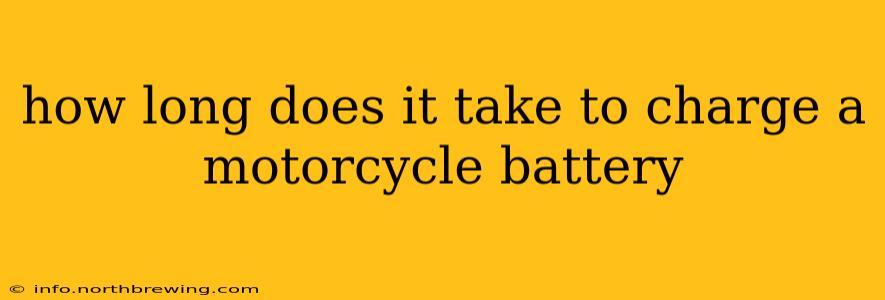Charging a motorcycle battery's duration depends on several factors, making a precise answer impossible. However, understanding these factors will help you estimate charging time and ensure your battery receives the proper care. This guide will delve into the specifics, answering common questions along the way.
What Factors Determine Motorcycle Battery Charging Time?
Several key factors influence how long it takes to charge a motorcycle battery:
-
Battery type: Different battery types (lead-acid, AGM, lithium-ion) have varying charging characteristics and acceptance rates. Lead-acid batteries, for example, generally take longer to charge than lithium-ion batteries. AGM (Absorbent Glass Mat) batteries fall somewhere in between.
-
Battery capacity (Ah): Amp-hours (Ah) represent the battery's capacity. A higher Ah rating means a larger capacity and thus a longer charging time. A 10Ah battery will charge faster than a 20Ah battery.
-
Charger type and amperage: The charger's output amperage significantly affects charging speed. A higher amperage charger will charge faster, but using too high an amperage can damage the battery. Always consult your battery and charger manuals for appropriate amperage levels. A slow charger (e.g., 0.8 amps) might take 10-15 hours, whereas a faster charger (e.g., 2-3 amps) could take 4-6 hours.
-
Battery's state of charge (SoC): A completely depleted battery will naturally take longer to charge than one that's only partially discharged.
-
Ambient temperature: Extreme temperatures (both hot and cold) can slow down the charging process. Ideal charging temperatures are typically between 60°F and 80°F (15°C and 27°C).
How Long Does It Typically Take to Charge a Motorcycle Battery?
While there's no single answer, here's a general guideline:
-
Lead-acid batteries: Expect charging times ranging from 4-12 hours depending on the factors mentioned above. A trickle charger might take even longer.
-
AGM batteries: Typically charge faster than lead-acid, often within 4-8 hours, depending on charger type and battery capacity.
-
Lithium-ion batteries: Charge much faster, usually within 1-3 hours, but require specific chargers designed for lithium-ion technology.
How Can I Tell When My Motorcycle Battery is Fully Charged?
Most modern chargers have indicators to signal a full charge. These might include lights, displays, or audible signals. Always refer to your charger's manual for specific instructions. If your charger doesn't have indicators, you may need to use a multimeter to check the battery voltage. A fully charged lead-acid battery will usually read around 12.6-12.8 volts.
What Happens if I Overcharge My Motorcycle Battery?
Overcharging can severely damage your battery, leading to reduced lifespan, performance issues, and even potential safety hazards. Always follow the manufacturer's recommendations for charging time and amperage.
Can I Leave My Motorcycle Battery on a Charger Overnight?
Leaving a lead-acid or AGM battery on a trickle charger overnight is generally safe. Modern chargers are designed to prevent overcharging. However, it's best to check your charger's specifications and follow its instructions. For lithium-ion batteries, it's crucial to use a charger specifically designed for them and to follow the manufacturer's guidelines, as leaving them on charge for extended periods could cause damage.
How Often Should I Charge My Motorcycle Battery?
Charging frequency depends on usage. If you ride your motorcycle regularly, the battery should stay adequately charged. However, if your motorcycle sits unused for extended periods, regular charging is necessary to prevent deep discharge, which can shorten battery lifespan. Consider using a trickle charger for long periods of inactivity.
By understanding these factors, you can better estimate the charging time for your motorcycle battery and ensure its longevity. Always consult your battery and charger manuals for specific instructions and recommendations.
